This post may contain affiliate links. Please read our disclosure policy.
This Rosemary Sea Salt Keto Bread has all of the same flavor and texture of real bread, but with a fraction of the carbs.
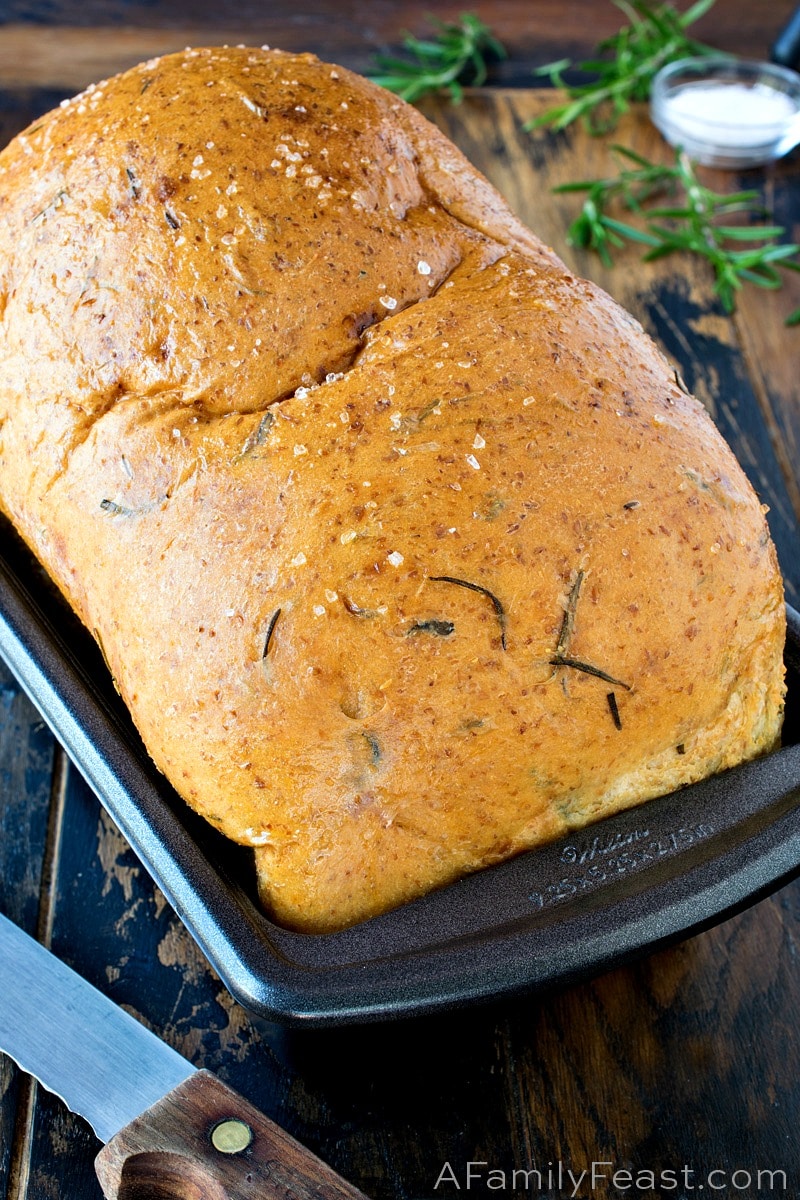
Hi everyone – Jack here. I’ve spent the last month or so trying to make a really good, nicely textured Rosemary Sea Salt Keto Bread, and after four attempts, I’m proud to say that I finally nailed it with this recipe.
I LOVE bread. But eating lower-carb these days has meant that most breads are (sadly) off limits for me. I made this keto bread recipe before, as well as this 90-second keto bread too, and they were good. But this Rosemary Sea Salt Keto Bread checks all of the boxes for me in terms of taste, texture and making me feel like I’m eating a ‘real’ slice of bread.
Now, I do want to point out that this Rosemary Sea Salt Keto bread is NOT gluten-free, but it is low in carbs at 2.4 net carbs per slice.
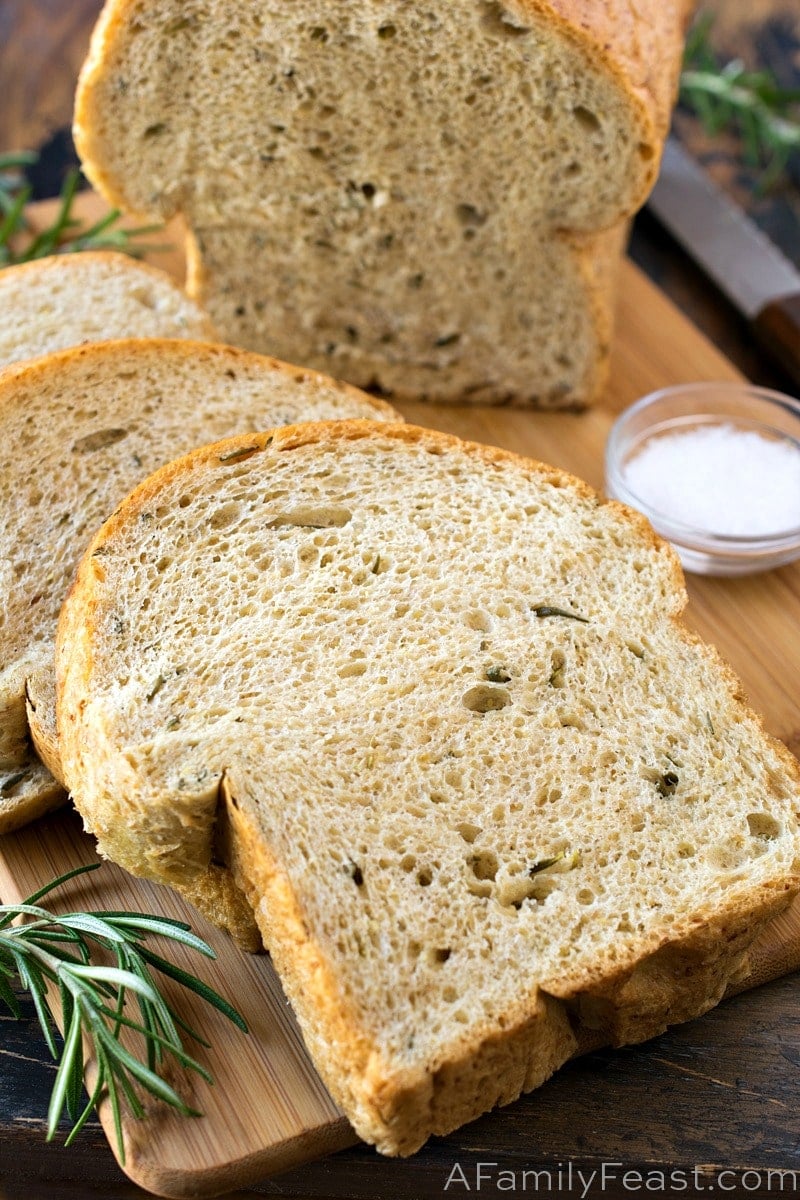
How do you make really good Keto Bread?
Most keto bread recipes out there rely on low-carb flours and xanthan gum powder as the base in their recipe – and ours does too. But – and here’s the trick – I also added wheat gluten to this recipe which adds that soft, bread-like texture that everyone knows and loves.*
Our Rosemary Sea Salt Keto Bread is also a yeast bread (which also contributes to that wonderful texture) but don’t let that scare you off. This is still a very easy and quick bread to make.
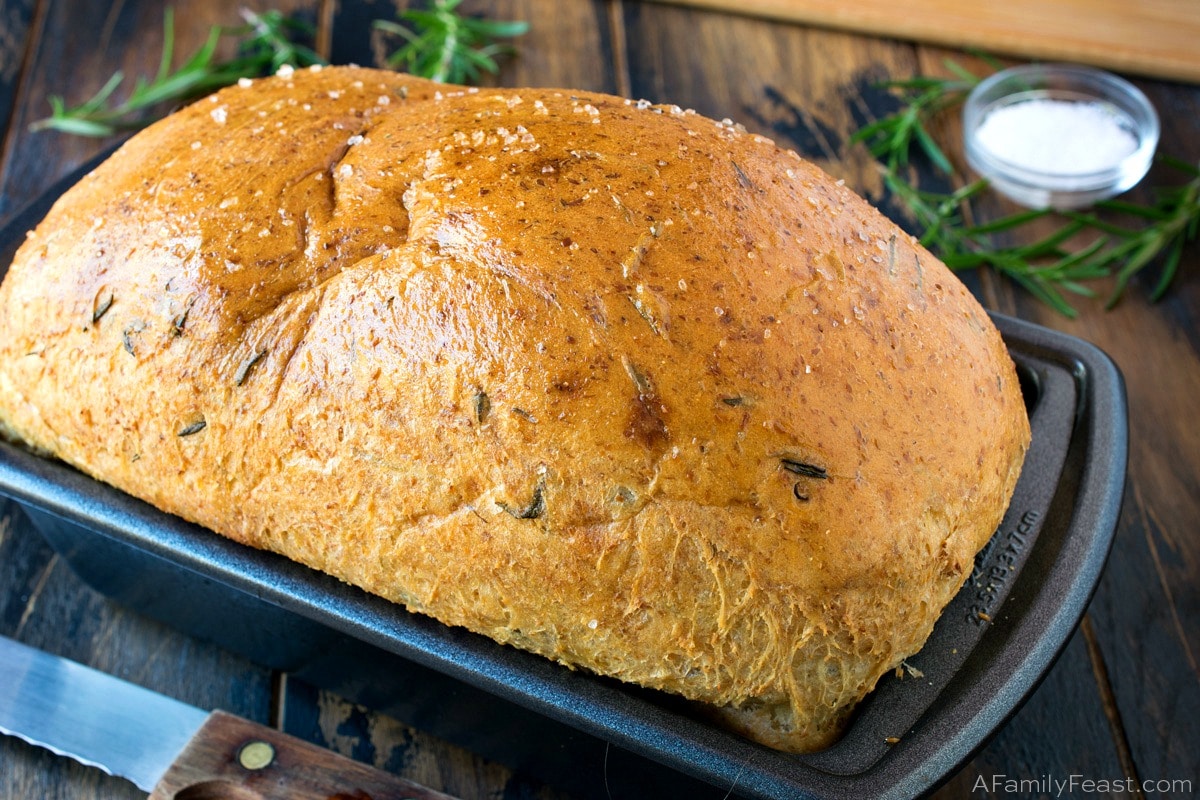
Today’s keto bread recipe uses ingredients that are easy to find online as well as in some well-stocked grocery stores including golden flaxseed meal, almond flour, oat fiber (don’t confuse that with oat flour), vital wheat gluten, and monk fruit sweetener (you could also use Stevia if you prefer). Once you have these ingredients in your kitchen pantry, the sky is the limit in terms of all of the different kinds of keto bread you can bake at home.
We flavored our Rosemary Sea Salt Keto Bread with (as you can tell from the name) fresh rosemary and coarse sea salt. Both give this soft, delicious bread some really fantastic flavor.
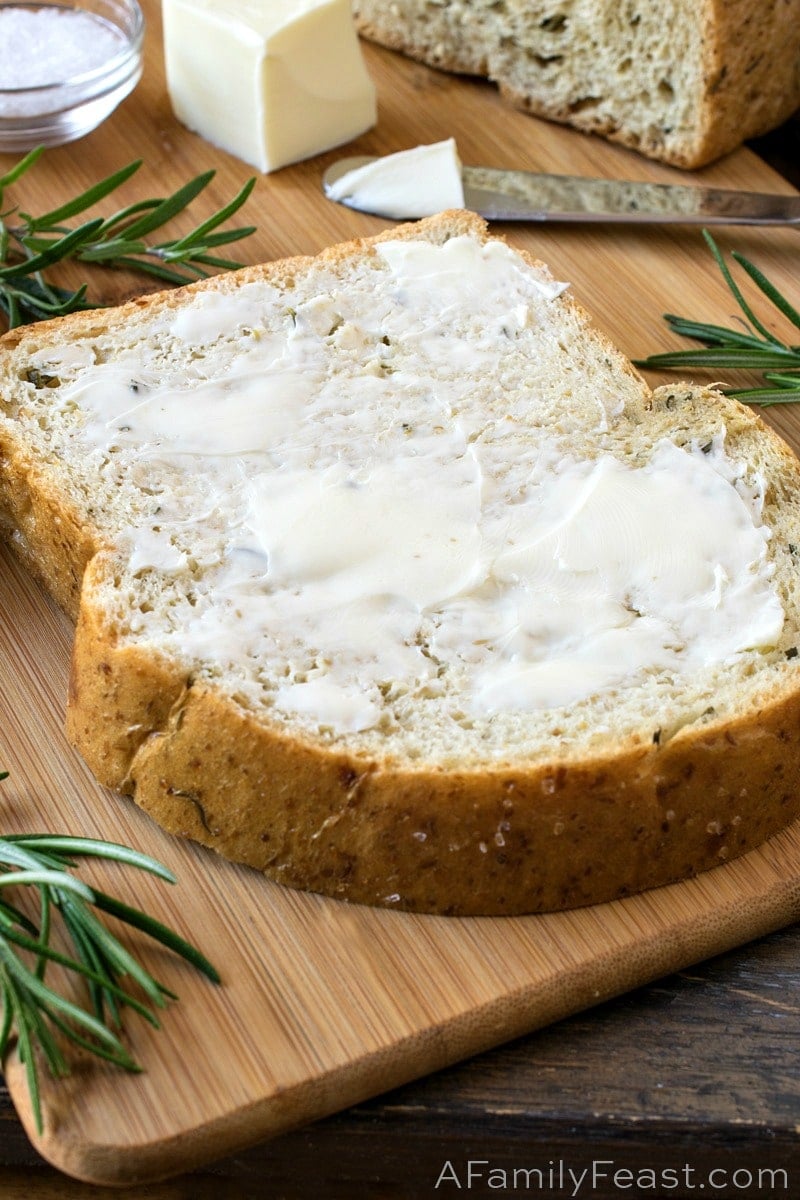
This Rosemary Sea Salt Keto Bread is great for sandwiches, toast, or simple bread and butter.
*Note: We’ve received a couple of comments from readers who have told us that using wheat-gluten in keto breads is the brain-child of a YouTuber named Deirdre. While we got our inspiration for this recipe from an assortment of other keto bread recipes and didn’t see Deirdre’s video ourselves until now, we wanted to note her as the original person (so we’re told!) who came up with the idea of using wheat-gluten to achieve that true, bread-like texture in keto bread recipes. You can see Deirdre’s video here.
You may enjoy these other Keto recipes:
- Keto Sheet Pan Pizza
- Beef and Kale Skillet {Keto, Low-Carb}
- Baked Western Omelet {Keto, Low-Carb}
- Chicken Tender Sauté
- Baked Sausage Egg Cups
We love seeing what you made! Tag us on Instagram at @afamilyfeast or hashtag #afamilyfeast so we can see your creations!

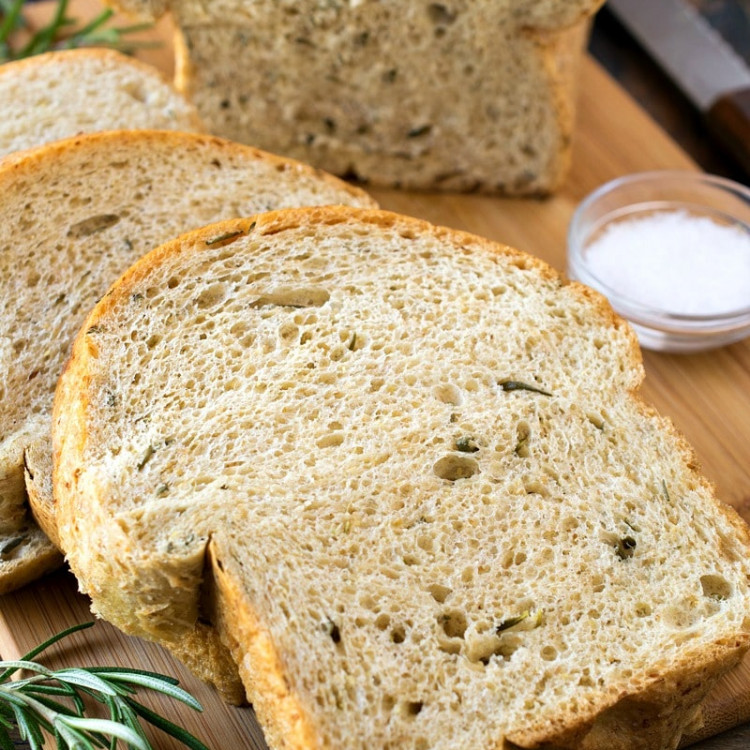
Rosemary Sea Salt Keto Bread
This Rosemary Sea Salt Keto Bread has all of the same flavor and texture of real bread, but with a fraction of the carbs.
Ingredients
1 cup tap water heated to exactly 110 degrees F.
1/2 teaspoon granulated sugar* or honey
2 teaspoons rapid rise dry yeast
3 whole eggs
3 tablespoons extra virgin olive oil
2/3 cup golden flaxseed meal
2/3 cup almond flour
3/4 cup oat fiber (not oat flour)
1 1/4 cups Vital wheat gluten
2 tablespoon monk fruit sweetener*, or granulated Stevia
1/2 teaspoon xanthan gum powder
1 1/2 teaspoon coarse sea salt (or kosher salt)
1 1/2 teaspoons garlic powder
1/2 cup fresh rosemary
Oil and coarse sea salt, for top of baked bread
Instructions
- Dissolve sugar in warmed water and add yeast. Set aside to bloom.
- In the bowl of a stand mixer with the paddle attachment, add eggs and beat five minutes on medium.
- Add olive oil and beat to combine.
- In a large bowl whisk together flax, almond flour, oat fiber, wheat gluten, monk fruit sweetener, xanthan gum powder, salt, garlic powder and fresh rosemary.
- Once the yeast has bloomed (froth formed on the top of the water), alternate adding the yeast mixture and the dry mixture until everything is in and mix on medium low for eight minutes. (The dough needs to be kneaded this long to develop the gluten.)
- Remove the dough and form into a neat ball with your hands then stretch to fit a 9X5X3-inch loaf pan. Do not oil or spray the pan, you want the dough to stick to the sides as it rises. Our 9X5X3-inch loaf pan was nonstick.
- Spray a piece of plastic wrap and place over the top of the pan so the dough doesn’t stick to the plastic.
- Proof for 1 ½ to 2 hours until doubled in size.
- I have an oven that I can set to 80 degrees F so I placed the dough in at that temperature then microwaved a 2-cup measuring cup filled with water until it was boiling hot and placed it in the oven with the dough. Then every thirty minutes I reheated the water until the dough doubled in size and was cresting the edge of the pan. In this humid environment, my dough rose in one hour and 45 minutes.
- You could also just use the inside cavity of your microwave with a container of hot water reheated every 30 minutes. Either have a tea kettle going to fill the cup or remove the dough and microwave the water then place the dough back in.
- Preheat oven to 375 degrees F with rack in center.
- Bake for 30 minutes until golden brown and when poked with a probe thermometer, will register between 190-200 degrees F.
- Remove from pan while hot by running a knife down each side to loosen, then cool on a rack. While hot, brush the top with olive oil and sprinkle on sea or kosher salt.
- Serve warm or cool and slice. Keep wrapped at room temperature like regular bread.
Last Step! Please leave a review and rating letting us know how you liked this recipe! This helps our business thrive & continue providing free recipes.
Notes
*Note: The sugar in this recipe is necessary to develop the yeast. The monk fruit sweetener is used to sweeten the bread and will not work in the initial blooming of the yeast.
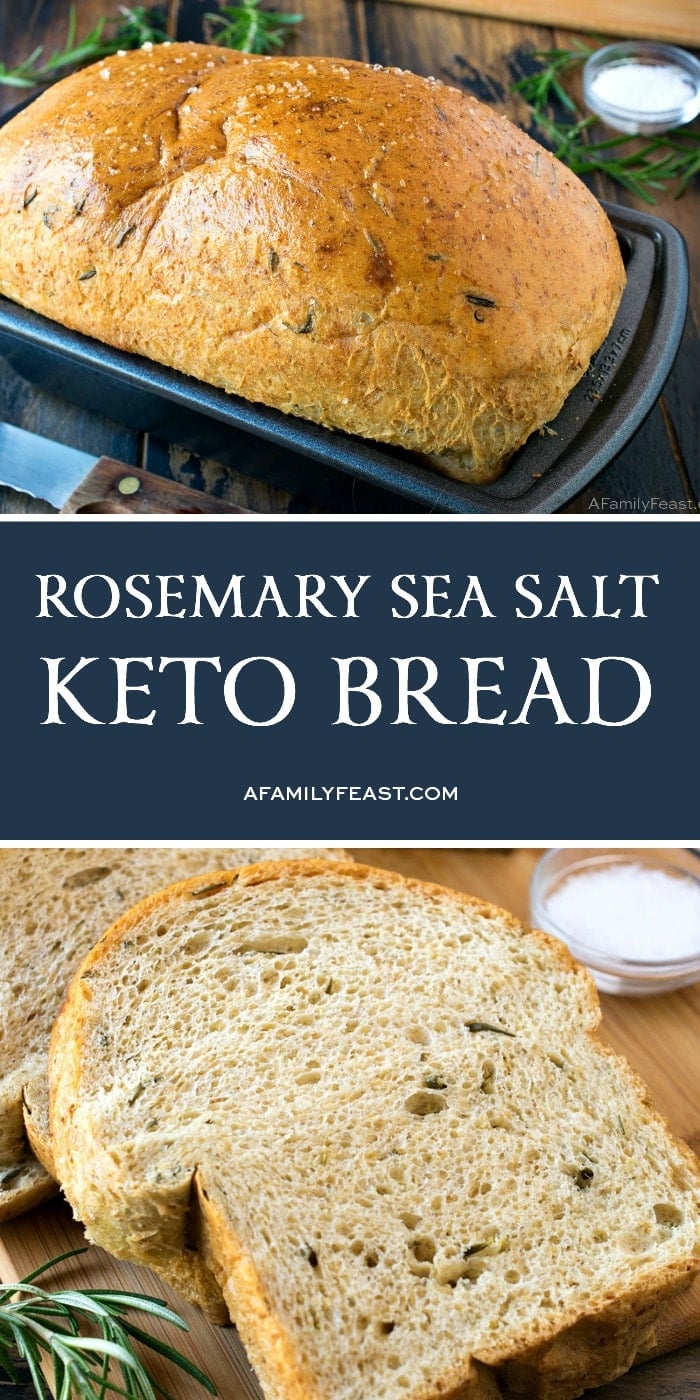
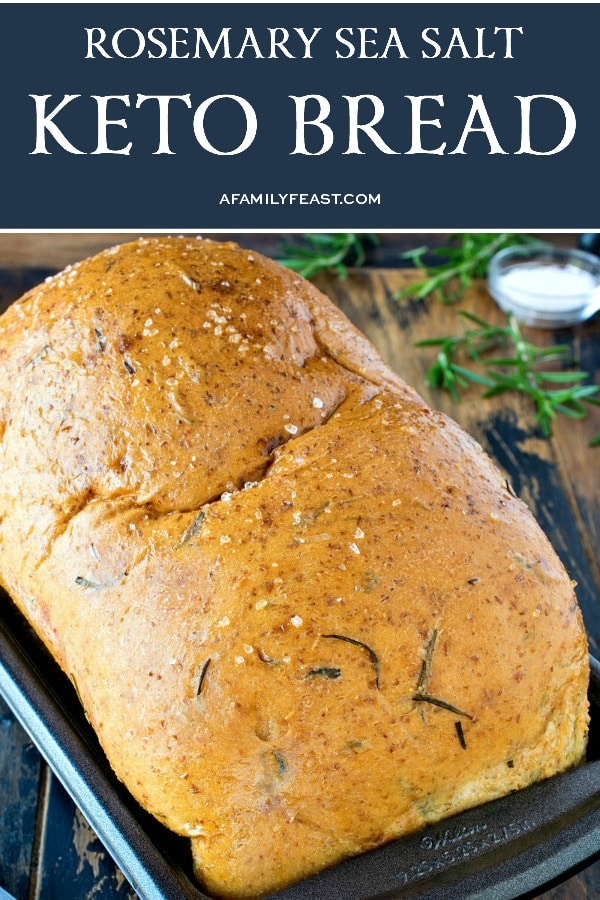
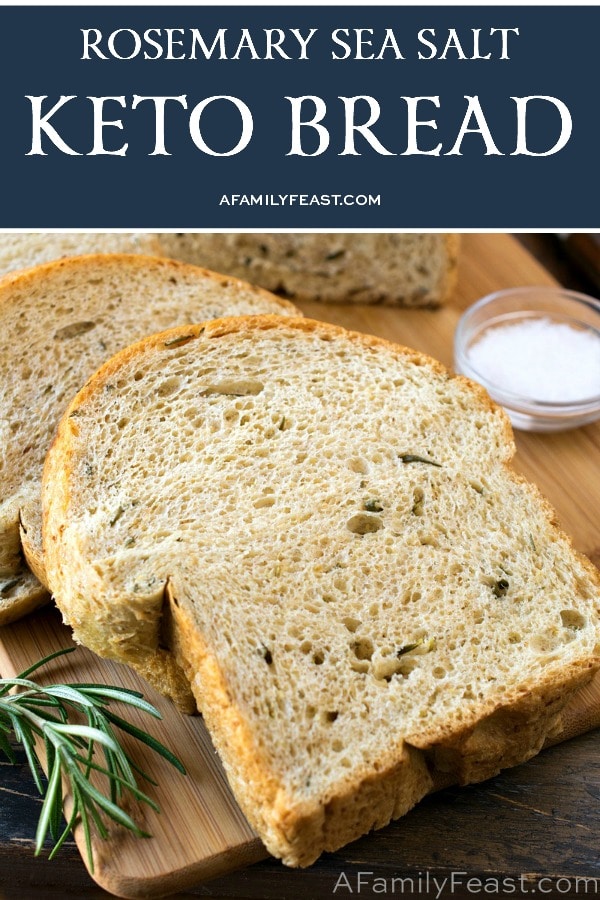

I followed the recipe exact, did not substitute any ingredient, and I even used the rapid rise yeast and it proofed beautifully. However the bread did not rise that much. The dough was too sticky to handle, and it filled up my 9x5x3 pan about halfway. It barely rose to reach the top and remained blobby sticky looking. It was in an upper oven with a temperature of 81-86°F the entire time, (lower oven set at 400° to make upper oven warm enough, and after 3-1/2 hours I gave up and cooked it. It is very dense, nothing like your pictures at all. I can’t figure out why it wouldn’t rise.
The only two things that happened differently in my prep is it may have been processed by my mixer 10-11 mins rather than 8. My fresh rosemary went bad and I was waiting for hubby to bring new home so that caused a few extra minutes of mixing. Also, I forgot to put a bowl of water in the oven with bread when rising. But that shouldn’t be necessary in a properly warm environment. Three and a half hours is a bit much when temps remained in the 80s. When I took it out the room thermometer I placed in the oven read 91° and 26 humidity. Why wouldn’t the bread rise properly?
juju
This is a very precise recipe and not very forgiving to minor variances. Breads that don’t use traditional ingredients, like bread flour are finicky.
Did you check the expiration date on your yeast? Also dry yeast is very susceptible to storage conditions. I used to keep my yeast packets in a cabinet near our stove and couldn’t figure out why my breads wouldn’t rise. Moved the packets to a cooler part of the kitchen and bingo, breads started to rise again.
Hope this helps
Jack
Hi, thank you for the quick reply! The yeast is brand new, just bought it last month. It bloomed beautifully, with a poofy froth rising thickly on the water and past the edge of the glass edge, so it was very fresh. I keep my yeast in the coldest cabinet of our kitchen away from our oven, but it is two cabinets away from the stovetop (separate from oven, which uses only the countertop, not the underneath space.) I don’t think yeast can be stored in the freezer, can it?? If so I could try buying new packets at the store and immediately placing them there? I didn’t make this recipe until I had the exact ingredients you listed, including the oat fiber and vital wheat gluten that I purchased just for this recipe. I already had golden flax meal from another recipe that warned you should always use the “golden” for baked goods. And every other ingredient was the exact same as listed. I did use 1 tsp honey instead of 1/2 tsp granulated sugar for the yeast, and as I said it bloomed beautifully so it chowed down on the honey. The bread is still very tasty. I do LOVE the flavor very much, which is why I want to figure out what I’m doing wrong so I can get it like yours. It’s just more the consistency of a banana bread or zucchini bread that doesn’t rise, moist like that, and not like a soft loaf of bread like in your picture, so it wouldn’t be that good for a sandwich or even dipping in Parmesan and olive oil. I would have been delighted if it turned out dense but like sourdough, because thats still at least drier with the bread texture, and is dippable, but it did neither. Also, I don’t know how I could have formed the dough into a neat ball. It was wayyy too sticky and stuck to anything it touched including my hands. To get it in the pan I had to put a bit of the wheat gluten on my hands to protect from sticking but it only worked against one touch then it stuck to my hands on the next pass. I was only able to plop it into the pan in separate globs. I was able to press it down flat into the pan with more powder on my fingers. It never formed a smooth surface and kept sticky peaks due to sticking to my hands. I would have had to grease my hands thickly with butter or olive oil to prevent that. I was worried that would jazz with the recipe so I just used a small dusting of the wheat gluten instead. I believe the stickiness of the dough has something to do with what also kept it from rising. The primary dry ingredients were 2/3 C each of golden flaxseed and almond flour, 3/4C of the oat fiber, and 1-1/4C of the vital wheat gluten. (Not including the remaining Ts and tsps of the seasonings and other dry ingredients) The wet ingredients were just the 1C water, 3 eggs and 3T olive oil. And it made a sticky mess, as if it needed more flour or something. What happens to the consistency when it is over mixed? Have you ever mixed yours longer than 8 minutes? Would that have any impact on too much moisture? I would have thought the opposite.
I’ve made this a few times following the steps precisely and have always had great results. In fact, a few times I over proofed it and it was huge when I put it in the oven. So something in your kitchen, ingredients or method must be different than mine. Wondering if your almond flour is too coarse or the other ingredients were not handled properly before you purchased? Just guessing here. My almond flour is ground fine and feels powdery rather than grainy. Also you doubled the honey from a half teaspoon to a full teaspoon. Don’t know if that is the cause but like I said, making a keto bread is very finite and doesn’t leave a lot of room for changes. The way you describe how you store the yeast sounds fine, but freezing, according to Mr Google is doable, although I have never tried that.
Last thoughts…1) Make sure wherever you proof the dough, you keep the air very humid. 2) This bread is not a dense bread and will bake up soft. 3) Follow the recipe as written. 4) Make sure all ingredients are fresh and stored properly. 5) Although it doesn’t state this, try bringing the eggs to room temperature first and make sure they are fresh.
I can’t think of anything else and really hard to diagnose and troubleshoot via written text like this, so all I can do is reinforce following the recipe to the letter of the law.
Hope this helps,
Jack
It does help and I am thankful for your kind and prompt replies, and your troubleshooting of my problem. I’m so envious that it rises so huge for you in your kitchen. LOL I’m going to keep trying because I can tell this bread will be amazing if I can get it to rise. Possibly it’s my almond flour. I use Bob’s Red Mill Super Fine, and it seems powdery in a large grain sort of way. I guess that’s subjective. Fluffy is more the term I would use. As a matter of fact every bag I open is clumpy and hard to measure unless I break up all the clumps first but they reform quickly when I scoop it out. I’ve tried King Arthur brand and even Walmart’s Great Value extra fine. Nothing is powdery and all of it is rather grainy or gritty in spite of advertising super fine. I do have problems with some other almond flour recipes so maybe this is the problem and for some reason we can’t get proper almond flour around the Chicago area. What brand do you use?
Hi Juju – We typically buy the Bob’s Red Mill brand or, if we are near a Costco, the Kirkland brand (linked in the recipe).
Hi. This bread sounds delicious. Want to try making it. Would you be able to provide ingredients in grams?
Hi Desiree – We prefer to provide our recipes exactly as we make them in our own kitchen and we don’t cook with metric measurements. You could try an online calculator to make the conversions but we often find that recipes don’t exactly convert based on those measurements. Sorry I can’t be more help.
Came out great! I used to love to make bread and this is a great recipe. I am just about at my goal weight so adding back in some recipes like this should keep me on track! I have lost 55 lbs on Keto and I am feeling so good now! Thanks for this amazing recipe!
Congrats Brent! So glad you enjoyed the recipe!
Very satisfied with this recipe. Easy to make ,the texture not like the rubber, taste good. I make gill chess and ice cream sandwiches is so good. The outside crispy and soft inside. I’m normally not good with yeast bread is always failed but this time is perfect for first time. This bread will be on the top of my list every week. Thank you so much
You’re very welcome – glad you had success with the recipe!
Hello, I made this. It’s nice. Can I substitute the vital wheat for more almond flour?
thanks
Hi Anna – They are completely different ingredients and serve different purposes, so without testing, I can’t say for sure if it can be swapped out on a one-to-one basis. The vital wheat gluten gives this bread the “real bread” texture. Replacing it almond flour will definitely change the texture, plus the almond flour has more moisture so I suspect other changes would be necessary.
I make this bread every week (I add 1/2 cup hemp hearts). The flavor and the texture can’t be beat. And it’s super easy to make
Thanks for the suggestion Maria!
I made this a few months ago and needed to freeze it. It was still great after a month.
Great to know Dale – thank you!
Hi Jack I want to do this in my bread machine do I do it as per my bread maker instructions?
Caroline
We do not own a bread machine and have never tried it. We have only made it as the recipe is written.
Wish I had a better answer,
Jack
Hi! I am making the Rosemary Sea Salt Keto Bread recipe but I am a little confused. When do you add the egg/oil mixture?
Hi Ellen – Eggs are added in step 2, oil in step 3.
Can you use egg substitute, such as Bob’s egg whites, instead of the whole eggs?
We’ve only made the recipe as written Patty so I can’t say for sure how the egg substitutes/egg whites will impact the recipe. Please let us know how it works out if you try doing so.